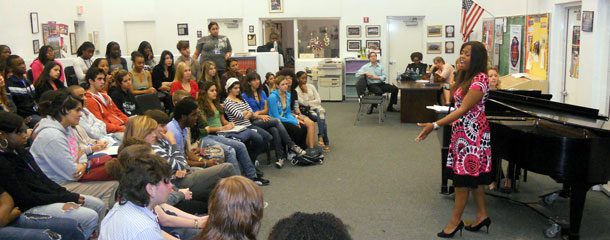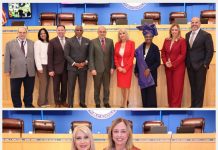
The opera season may be over, but students have been reaping the benefits of this timeless art form thanks to Florida Grand Opera’s (FGO) educational programs, which bring opera into the classroom.
On May 22, the opera company’s head of costuming, Camilla Haith, visited Richmond Heights Middle School to give students a first-hand account of how academic subjects play a daily part in making garments for the stage.
“The thing I want to talk to you guys about today is that, even though my education is extensive, most of the things that I use in my job I learned in grade school and high school,” Haith said.
With two bachelor’s degrees and a master’s degree, Haith assured students that their present studies lay an important foundation for their future and discussed three basic subjects — history, math and art.
With costumes from the company’s latest production of Verdi’s La traviata adorning the stage behind her, Haith began explaining the importance of historical context in theater.
“Creating an opera means creating a world. When you decide what the parameters of that world are going to be, then everyone on stage must exist inside that design,” she said.
When delving into the topic of fashion history, students were often surprised by what trends dictated in the 1800s. They gasped at the thought of shorts and tanks tops being considered indecent attire and laughed at the revelation that men regularly wore corsets.
Up next was the topic of math.
“Geometry is a subject I hated and didn’t understand why I took it and, now, all I do is geometry all day,”Haith explained to the student’s surprise
Geometry, being the study of shapes, is a necessity when constructing patterns to make costumes. In charge of thousands of costumes per season, it’s important that her math is perfect. Art class is equally significant when it comes to applying color theory to dying fabrics. Beyond knowing the primary colors, it’s crucial to recognize how they work together to make secondary colors and so on.
Haith wrapped up her lecture with a Q&A and encouraged students to seek internships to fully explore their opportunities.
Her final piece of advice: “Never look at the arts as something you do in your spare time that isn’t going to give you a future,” she said. “A future is there if you want it.”






